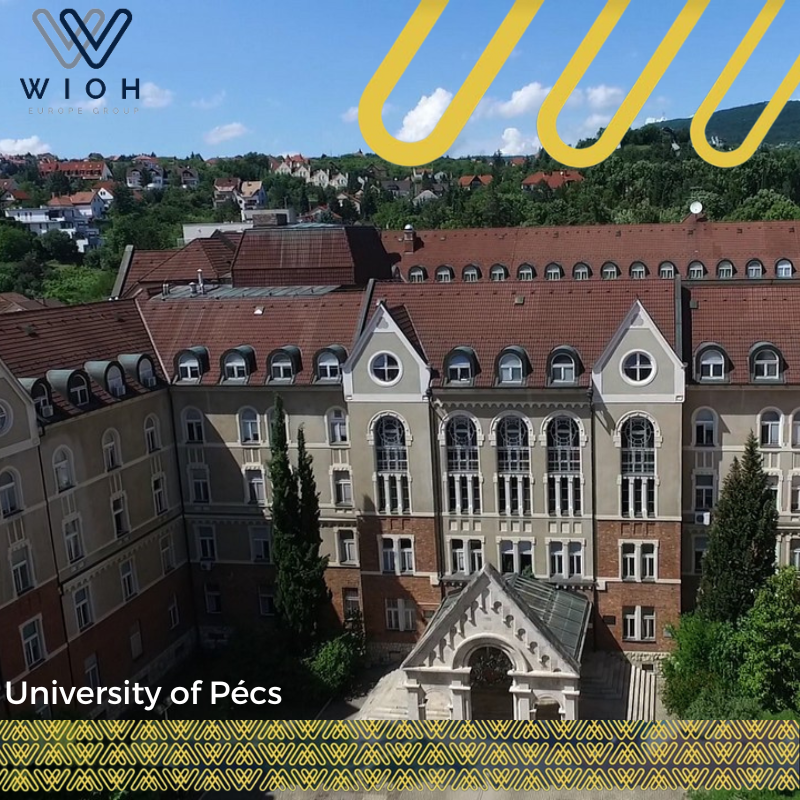Poznan University of Medical Science is one of the best medical universities in Poland
University Rankings:
_ According to SJR, the university ranked 8 in Poland and 434 in the world for the year 2021 AD.
_ According to USNews, it was ranked 20th in Poland and 1413th in the world for the year 2020.
_ According to the Naturel Index, it ranked 20 in Poland and 2023 in the world for the year 2020.
University history:

_ In 1919, the University of Poznan (hereinafter referred to as UP) was created as an opportunity to develop academic medicine and pharmacy in the city of Przemysław. The first dean of the University of Poznan, Prof. Heliodor Šwicci, obstetrician and gynecologist.
_ The UP Senate, at its session in 1920, approved the concept for the development of the medical school by Prof. Wrzoska, then in September 1920, he formed the College Board.
The Council met in its first session on November 19, 1920, doctors and pharmacists were built almost from scratch to lead a research and education center in Poland, whose development was interrupted by the outbreak of World War II.
_ In 1950, the Medical Academy was established which was renamed the Poznan Medical Academy (hereinafter referred to as AM)
_ AM was established in the city on the Warta River, on the basis of departments and departments affiliated with the Faculty of Medicine with the Department of Dentistry and the Faculty of Pharmacy, separated from Poznań University, and the Faculty of Pharmacy.
_ The development of AM in Poznan in 1950-2018 was influenced by both external and internal factors. The democratic elections of academic authorities in the universities were re-run. The new rector of the Poznan Academy of Music was elected as a professor. Anthony Hurst and members of college councils elected deans and vice deans. An important decision was the acquisition of control by the Poznan Medical University of state clinical hospitals, which allowed to improve the quality of education of medical students, as well as to intensify clinical trials.
_ In the period 1956-198, it gradually developed its scientific, clinical and teaching capabilities. One of the greatest achievements of this period was the establishment of a leading center in orthopedics and rehabilitation in Poznan in Europe, under the direction of its founder, Professor Wiktor Dega
_ It became a center for the fight against polio, in addition to implementing an innovative concept for the treatment and rehabilitation of people with disabilities. On the other hand, in the scientific field of the Academy of Medical Sciences in Poznan,
_ New units were created that allowed for innovative research to be carried out. The first in the country to be established at the University of Poznan, among others: Electron Microscopy Laboratory (1956), Isotope Center (1957), Laboratory of Artificial Kidneys (1958), Nutrition Center (1959), Clinic for Parasitic Diseases (1961), Department of Industrial Rehabilitation (1968)), Department of Hand Surgery (1969).
_ At that time, the level of education undoubtedly increased, as well as the desire to expand the scope of higher education with auxiliary medical personnel. Thus, in addition to the faculties of medicine, dentistry and pharmacy, in 1975 a fourth field of study was created – nursing, and accordingly a new faculty was created – the faculty of nursing. Another sign of AM boom was the concept of expanding the university.
In 1981 the Senate adopted a resolution naming AM after Karol Marcinkowski, a prominent Poznan physician, social and patriotic activist.
_ 1989 Poznan Academy, under the supervision of the President of the University, Prof. Anthony Prozevic, adopted the principle of independent and effective scientific, educational and organizational policy, which led to actions that increased the level of student education, the quality and quantity of scientific research, as well as the medical services provided.
One of the ways to achieve these goals was the establishment of the Faculty of Medicine in 1992, which soon turned into Faculty of Medicine 2. The new faculty included – the Department of Postgraduate Education and the Department of English Education, teaching first in Poland for English-speaking students, mainly from the States United States of America. The former medical school was also renamed Primary Medicine, and the College of Nursing eventually became the College of Health Sciences in 1998, greatly expanding its educational offering to include new fields of study. As a result, the university’s economic situation has improved, as well as the development of new investments in research, education and clinical facilities. All these activities have led to an increase in the quality of teaching and the level of scientific research at the Poznan Academy. This allowed the use of the Law on Higher Education and the transfer of the Medical Academy in 2007 to the Medical University of Karol Marcinkowski in Poznan. The Poznan Medical University became the first medical university in Poland to obtain university status.
_ In 2014, the University Center for Medical Biology was opened and the many decades of history of the Poznan University of Medicine culminated in the opening of a new medical simulation center in 2018, whose building was named after the first dean of the Faculty of Medicine, Prof. Adam Wrzosek, founder of medical studies in Poznan in 1920. So the event was symbolic in nature, because in this way, after almost a hundred years, one of the founders of academic medicine was celebrated in Poznan.
_ In October 2019, new authorities and units began to work, including the University Council, four faculties – the Faculty of Medicine, the Faculty of Medicine, the Faculty of Pharmacy and the Faculty of Health Sciences, three faculties of sciences – Medical Sciences, Pharmaceutical Sciences and Health Sciences, headed by professors, and doctoral school in Pozna City Hall. This reform opens the second century to academic medical studies in Poznan.
Teaching staff:
Students: There are approximately 8000 students, including about 1000 English-speaking students from more than 50 countries.
Specialties: There are 22 fields of study in UMP
Campus:

As for the infrastructure, the medical university has favored itself with new buildings located on its campus. In 2004, the architecturally impressive collegium Stomatologicumc at ul. Bukovska 70; In 2007, the construction of the Congress and Education Center in the Mujahideen. Przybyszewskiego 37, with a modern main library at ul. Przybyszewskiego 37,
Faculties:
The university campus includes four faculties:
_ College of Health Sciences: Fields of Study
Social and Preventive Medicine, Neuroscience, Occupational Health, Cell Biology, Clinical Psychology, Community Health, Midwifery, Health Administration, Public Health, Physical Therapy, Biological and Life Sciences, Natural Sciences, Health Sciences, Medicine, Social Sciences, Nursing, Psychology
_ Faculty of Medicine I: Fields of study:
Parasitology, Orthopedics, Neuroscience, Oncology, Epidemiology, Ophthalmology, Anesthesia, Pediatrics, Pathology, Obstetrics and Gynecology, Genetics, Radiology, Physiology, Surgery, Microbiology, Biological and Life Sciences , health sciences, medicine, biology
_ Faculty of Medicine II: Fields of study:
Dermatology, Dental Technology, Cardiology, Orthopedics, Immunology, Nutrition, Laboratory Techniques, Psychiatry and Mental Health, Pediatrics, Anatomy, Health Education, Physiology, Surgery, Microbiology, Dentistry, Technology Biology, biological and life sciences, health sciences, medicine, chemistry
_Faculty of Pharmacy: Fields of Study:
plant diseases, physical chemistry, inorganic chemistry, analytical chemistry, cosmetology, toxicology, organic chemistry, applied chemistry, laboratory techniques, botany, molecular biology, natural resources, medical technology, pharmacology, biochemistry, biotechnology, versus, Biological and life sciences, natural sciences, health sciences, medicine, chemistry, economics of requirements
University’s library:
The Main Library of the Medical University of Poznan has existed since 1952. It was built on the basis of the collection of the library of the former Faculty of Medicine, until 1984, the main library was located on one floor of the university building, and in 1985 it moved to work in its own facility.
_ Between 1971-1974 organizational changes occurred for the library network, 10 branch libraries were created, as these were institutions created on the basis of several departmental and clinical libraries.
_ Until 1979 there were 21 libraries, in the following years most of the branch libraries were converted into institutes libraries, and departmental libraries were established for the College of Pharmacy and the College of Health Sciences.
_ In 2010, the main library moved to the new building of the Medical-Scientific Information Center at ul. Przybyszewskiego 37a.
_ The library provides services, including the following types of work:
Inter-library loan
Import original documents from Polish and foreign libraries
Import copies of documents from Polish and foreign libraries
Scientific Information Services
Bibliographic thematic compilations
Lists according to different search keys
Verification and completion of bibliographic data
_ Six Documaster Campus system multifunction devices are located in the library, where students and university staff can copy, scan and print the documents they need.
University Clinical Research Support Center
The University Clinical Research Support Center in Poznan (UCWBK) conducts clinical trials on its own outpatient basis and on the clinical base of five clinical hospitals, with access to a wide range of patients.
The research is carried out from the first stage to the fourth stage after registration.
_ Researchers have expertise in the following therapeutic areas: oncology, hematology, chemotherapy, gynecology, pulmonology, cardiology, cardiac surgery, hypertension, metabolic diseases, rheumatology, neurology, neonatology, medicine Pediatrics, orthopedics, ophthalmology, gastroenterology, diabetes, endocrine surgery, organ transplantation and dermatology.
_ The establishment and operation of UCWBK in Poznan was funded by the Medical Research Agency as part of the project “University Center for Clinical Research Support (UCWBK) – Clinical Trial Development Strategy, including comprehensive support for non-commercial clinical trials in North-West Poland”
The University’s Clinical Research Support Center operates as part of the Karol Marcinkowski University of Medicine in Poznan, a member of the Polish Clinical Research Network (PSBK).






